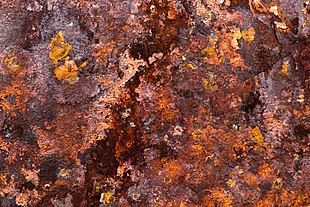A Chemical Natural Phenomenon: Rusting of Irons

Rusting of Irons (Fe)
Let's talk about natural phenomenons. They are reactions (or called: phenomenons) that occur naturally, catalyzed by nature. Here, I'd like to explain to you about one of the more chemical natural phenomenons: rusting of irons.
Rust is an iron oxide, usually colored red, which is a product of a redox reaction between iron and oxygen in the presence of water or air moisture. It consists of the chemical element Fe2O3·nH2O ,FeO(OH), and Fe(OH)3.
Rusting is a spontaneous process, which means that it occurs naturally without needing outer energy given into it. If there's enough oxygen and water around it, given enough time, rust will form and completely covers the whole iron. Irons with rust aren't as strong as their original counterparts, they are really flaky and weak.
Now, let's see the process in a more chemical way!
Keyword: Redox Reaction
Rusting of irons are basically a redox reaction, an electrochemical process that begins with transfer of electrons from iron to oxygen. Irons gives out electrons to oxygens, which means they are reducing agents. It reduces O2 to form hydroxide ions. In this process, irons become the iron(II) or iron(III) ion.
Reduction of oxygen:
Oxidation of iron:
Fe → Fe2+ + 2 e−
4 Fe2+ + O2 → 4 Fe3+ + 2 O2−
Fe2+ + 2 H2O ⇌ Fe(OH)2 + 2 H+
Fe3+ + 3 H2O ⇌ Fe(OH)3 + 3 H+
Now, let's talk about one more thing. If the reaction of the rusting of irons depends strongly on the amount of oxygen and water around it, why does an acid's presence makes the process much faster?
It turns out that strong acids (such as HCl) have a very acidic proton (H+) which will readily form into H2 gas when reacting with metals. It reduces them, hence making them an oxidizing agent which will help to oxidize metals.
One example reaction is the reaction of HCl with Na metal.
2Na + 2HCl -> 2NaCl + H2
Now, let's talk about how to prevent rusting from happening. Have you ever heard about stainless steels?

Stainless steel is actually irons surrounded by a protective, chromium oxide layer. The presence of chromium, which has a lower reduction potential than iron (which makes it more readily to be oxidized) will prevent the iron from being oxidized.
Another way is to "galvanize" which is basically coating steel with zinc to prevent it from rusting. This is usually more preferred because zinc is cheap and adheres well to steel compared to it's chromium counterpart.

A galvanized street lamp in Singapore
Now, let's talk about how do we remove rusts easily! One of them involves the use of vinegar.

Recall that using strong acids will catalyze the reaction of rusting. Now, why does vinegar, an acid, able to remove rusts?
Vinegar consists of acetic acid (CH3COOH) which is a weak acid. It isn't as terribly very oxidizing compared to the stronger acids out there. And, chemically:
3CH3COOH+FeOOH⟶Fe(CH3COO)3+2H2O
FeOOH, which is one form of iron rust, will turn into Fe(CH3COO)3 which is water soluble, which means it will not leave as a solid residue.
That's it for this article. I hope you find this interesting and I hope this will be useful for all of us!
Source:
Heinz, Norbert. "Corrosion prevention - HomoFaciens". www.homofaciens.de. Archived from the original on 2017-12-01. Retrieved 2017-11-30.
Holleman, A. F.; Wiberg, E. (2001). Inorganic Chemistry. San Diego: Academic Press. ISBN 0-12-352651-5.
Gräfen, H.; Horn, E. M.; Schlecker, H.; Schindler, H. (2000). "Corrosion". Ullmann's Encyclopedia of Industrial Chemistry. Wiley-VCH. doi:10.1002/14356007.b01_08.
Source:
Heinz, Norbert. "Corrosion prevention - HomoFaciens". www.homofaciens.de. Archived from the original on 2017-12-01. Retrieved 2017-11-30.
Holleman, A. F.; Wiberg, E. (2001). Inorganic Chemistry. San Diego: Academic Press. ISBN 0-12-352651-5.
Gräfen, H.; Horn, E. M.; Schlecker, H.; Schindler, H. (2000). "Corrosion". Ullmann's Encyclopedia of Industrial Chemistry. Wiley-VCH. doi:10.1002/14356007.b01_08.
Komentar
Posting Komentar